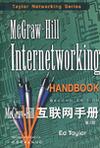McGram-Hill互联网手册
2000-4
世界图书出版公司北京公司
E.Taylor
876
In Retrospect En route to San Francisco, CA, August, 1993 for the Interop conven-tion, I contemplated the history of internetworking as I ate lunch dur-ing the flight. After lunch, I wrote my thoughts on a napkin. They were: First came something, next came a variety, chaos followed. Pain broughtforth integration; ignorance en masse followed. An awareness of gridlock appeared. Education culminated in a glut of information. An attempt to harness this information followed. Mankind awaited its destiny. 8-24-93 Ed Taylor Purpose of This Book.
Preface xvAcknowledgments xviiPart 1 Networking Fundamentals Chapter 1. Commonalitles among Networks 1.1 Perspective 1.2 Topologies 1.3 Transmission Media 1.4 Physical CommunicaUon Link Configurations 1.5 Additional Information 1.6 Summary Chapter 2. Data Communication Considerations 2.1 Signal Characteristics 2.2 Data Representation 2.3 Transmission Characteristics 2.4 Multiplexing 2.5 Physical Interface Considerations 2.6 Interface Standards 2.7 Modems 2.8 ADSL Technology 2.9 Additional Information 2.10 Summary Chapter 3. Protocaol Fundamentals 3.1 Perspective 3.2 Network Layers: A Practical Perspective 3.3 Summary Chapter 4. Types of Networks 4.1 perspective on Networks 4.2 Networks by Category 4.3 Data Networks 4.4 VoiceNetWorks 4.5 Video Networks 4.6 Multimedia Networks 4.7 Inter net 4.8 Intranet 4.9 SummaryPart 2 Lower-Layer Protocols Chapter 5 Lower-Layer Protocols: A Practical Perspective 5.1 Ovewiew 5.2 Lower-Layer Protocols in General 5.3 summary Chapter 6. Asynchronous Transfer Mode (ATM) 6.1 A Perspective on ATM 6.2 ATM Layer Structure 6.3 ATUAdaptatlonLayer(AAL) Functions 6.4 ATM Ceil Strueture and Contents 6.5 ATM Interface Types 6.6 ATM Concepts 5.7 ATM Implementation 6.8 ATaPhysicaI-LayerArehitecture 6.9 ATM Terminology 6.10 Where to Find Additional Information 6.11 Summary Chapter 7. Enterprise Systems Connection (ESCON) 7.1 Overview 7.2 Hypothetical ESCON Environment 7.3 ESCON Components Found in a Typical Insta&lation 7.4 ESCON Manager Program 7.5 ESCON Orientation 7.6 ESCON Protocols 7.7 ESCON physica(-Layer Specifications 7.8 Additional Information 7.9 Summary Chapter8. ETHERNET 8.1 Origins, Evolution, and Versions ……Part 3 Upper-Layer ProtocolsPart 4 Network DevicesGlossaryAcronyms and AbbreviationsRFC ListingTrademarksBibliographyIndex
AppleTalk is a protocol used to connect Macintosh computers together to make a network. AppleTalk is a proprietary protocol. The Apple Corporation itself had a line of Apple computers before the Macintosh line was introduced. In approximately 1984, the Macintosh was intro- duced. In many ways the rest is history-if you are familiar with Macintosh computers. AppleTalk has had two phases, or versions, Versions l and 2. Prior to the Macintosh, Apple did not have a networking solution for their com- puters. However, this is not a negative statement; it is merely factual. In the late 1970s basically three "personal computers existed; they included: the Apple, Tandy Corporation's TRS-80, and Commodore's Computer. As history revealed, in 1981 that changed when IBM intro-duced their first personal computer, So, the point is at that time what are now considered personal computers were not prevalent in the world of networking, as Ted Taylor explained. ……
